In the studio with Mura Masa, pop's mischief-maker-in-chief
The Grammy-winning producer's new album is a no-fucks-given embrace of mischief, spontaneity and fun. We visit him in his South London studio to find out more
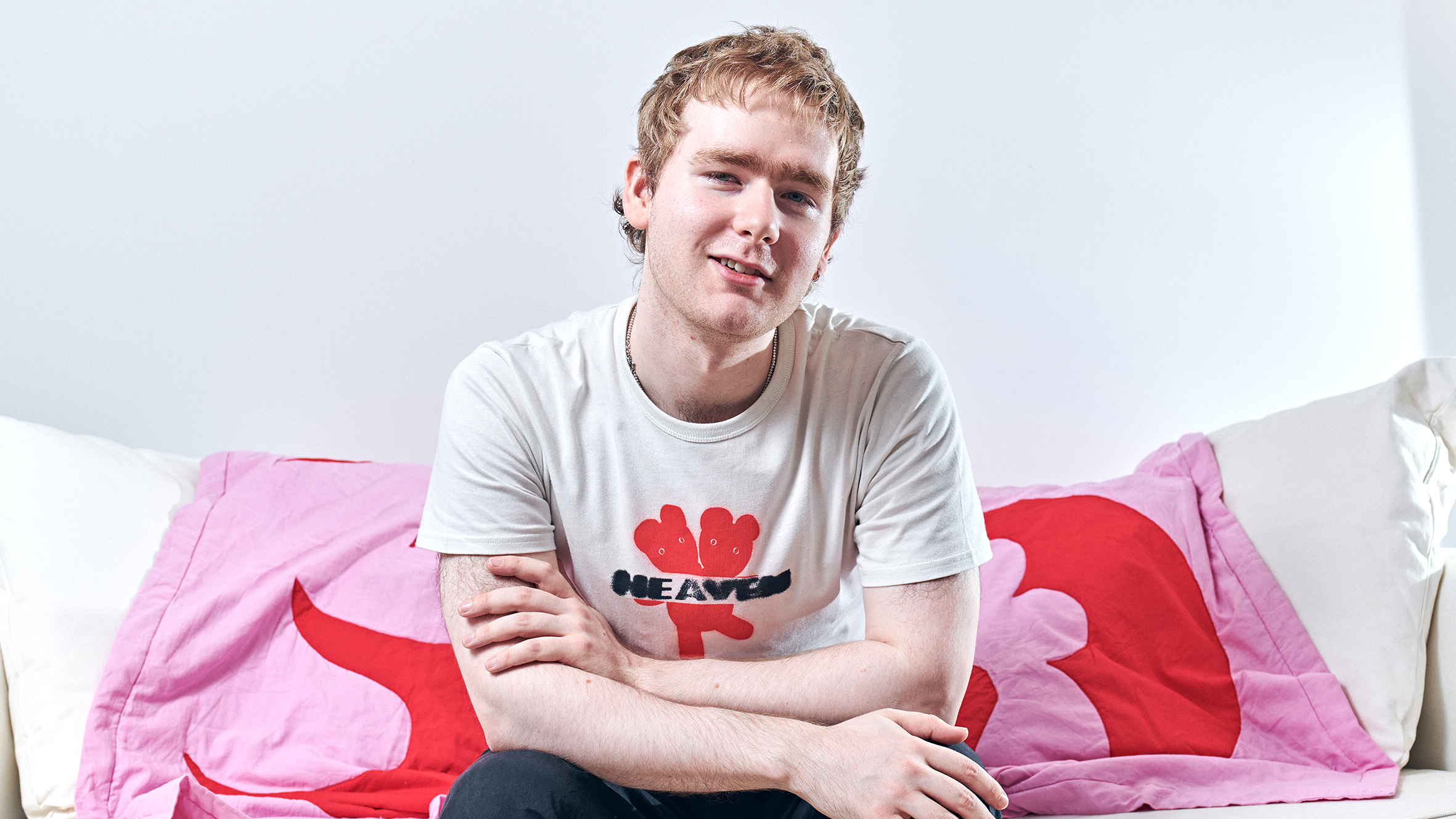
As we enter Alex Crossan’s home studio, housed in a modestly sized room at the end of his shady South London garden, we’re politely asked to remove our shoes.
This isn’t only to preserve the white carpet, though - the producer tells us that the no-shoes policy is an idea pinched from Rostam Batmanglij of Vampire Weekend, who himself pinched it from Rick Rubin. By popping off their shoes, the thinking goes, you invite your collaborators to let their guard down, opening up the studio to become a more loose, playful and unrestricted space.
Those three words neatly capture the spirit of demon time, Crossan’s third album as Mura Masa. A no-fucks-given embrace of fun, riot and mischief, the project was conceived during lockdown as a means to combat the introspection and isolation faced during the early days of the pandemic.
“The key word just became fun. That became the driving force behind the sonic palette of the album,” Crossan tells us. “Demon time is that 1am to 6am period, you’re maybe a little bit too drunk, maybe doing something you might regret, but not really - secretly you thought it was quite fun.”
Born and raised in Guernsey, Crossan cut his teeth playing guitar and drums in the island’s DIY scene before the sounds of early-’10s post-dubstep compelled him to pirate a DAW (or three) and begin making beats. He soon landed airplay on Radio 1, with feverish buzz surrounding his early singles landing him features from Charli XCX, Damon Albarn, A. K. Paul and A$AP Rocky on his self-titled debut.
It was the latter’s contribution to “Love$ick” that gave the producer his first fully-fledged transatlantic hit, with Rocky’s self-assured flows pushing the already fiendishly catchy, steel drum-laden instrumental into viral territory.
Grammy nominations followed - along with a win, for his 2019 HAIM remix - as did his second album, R.Y.C. A sharp left-turn into anxiety-laced guitar music, the project divided critics, but found Crossan standing firm in his desire to subvert expectations.
Want all the hottest music and gear news, reviews, deals, features and more, direct to your inbox? Sign up here.
He’s stated before that on R.Y.C., he “skipped the difficult second album and made the weird fourth one." When we ask what that makes demon time, he tells us that perhaps this album is a “renaissance”, and a return to form. He’s not wrong.
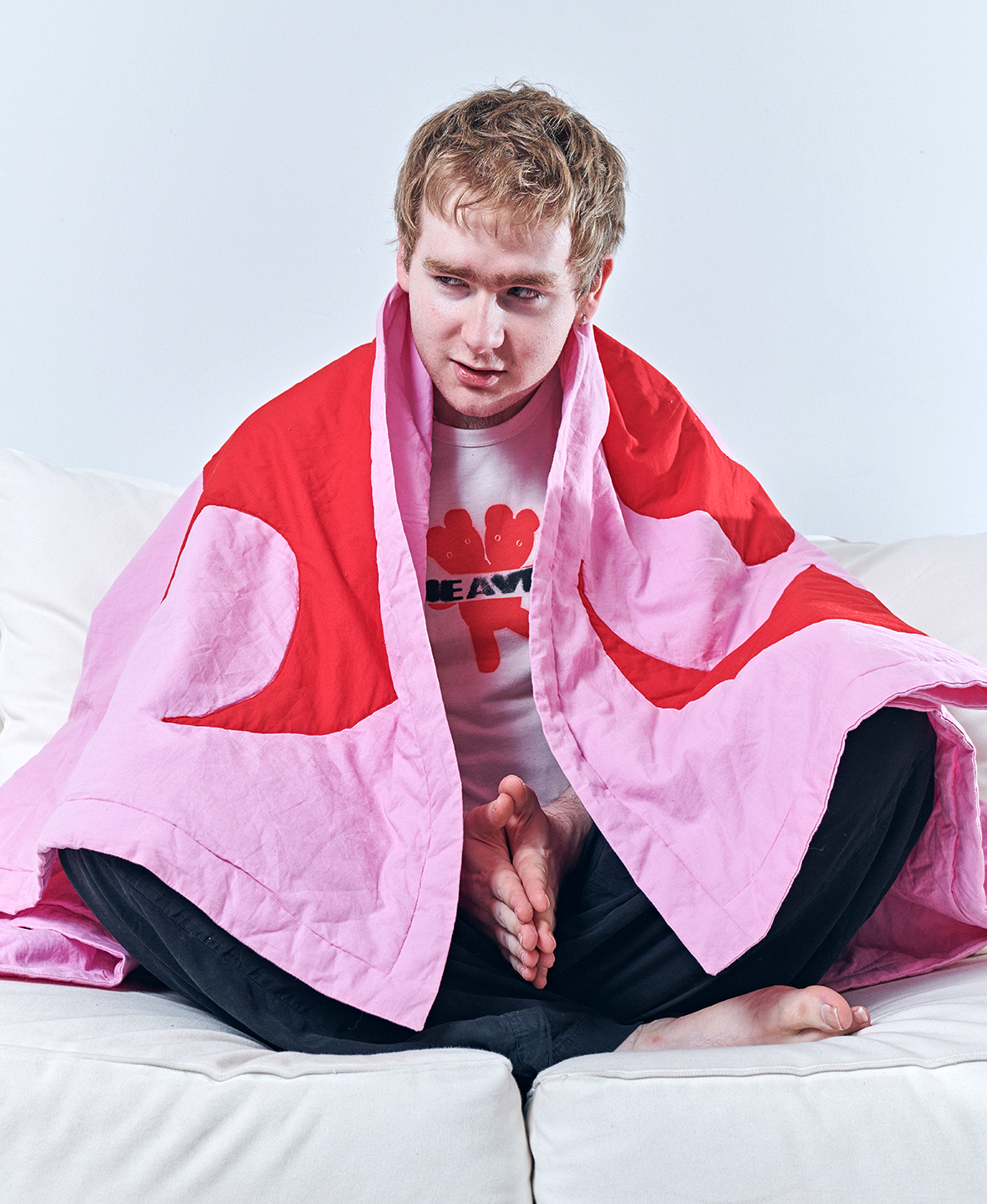
Across eleven tracks of unruly, future-facing pop music, Crossan holds a fractured mirror to our hedonistic, attention-deficient world, and finds it looking back with a mischievous grin. The album zips between more genres than we care to name, inviting a varied cast of collaborators on a giddy, endorphin-rushing tour of his musical influences.
On “bbycakes”, Crossan flips 3 of a Kind’s cutesy UKG hit of the same name into something closer to drill, throwing in features from Lil Uzi Vert, shygirl and PinkPantheress to elevate the track from mash-up to magnificence. “slomo” invites Midas the Jagaban - a balaclava-wearing British-Nigerian artist best known for her work in Afrobeats - into a pitch-shifted, hyperpop universe, while album highlight “2gether” collides downcast grunge with face-melting, EDM-adjacent sound design, to breathtaking effect. (When a sampled voice exclaims “Jesus Christ!” on the drop, you feel it in your gut.)
Critics might say it sounds more like a playlist (or a scroll through TikTok) than an album, but that’s missing the point entirely. The record’s born of a slap-happy desire to toss expectations out the window, with every aspect of its creation, from the lyrics and artwork through to the finer details of the production, embodying the mischief and mayhem implicit in its arch-concept: demon time.
Back in Crossan’s studio, we’re beginning to talk through his creative process, and there’s something he’d like us to know. He’s keen to inform us that if there’s one thing he wants people to take away from this interview, it’s that when it comes to music production, he truly doesn’t know what he’s doing. "Maybe what I want people to take away from this is how incompetent I am," he admits, with a laugh.
The Grammy-winning 26-year-old’s modesty is admirable, if a little misplaced - he’s notched up north of a billion streams and worked with more household names than most producers do in an entire career - but the confession touches on something essential about his approach to music-making.
“There's a whole approach that does away with the technical snobbery of production, that’s just about output,” he tells us. The practice of music production is beset by protocols to follow, conventions to observe, techniques to learn, menus to dive through and manuals to read. But for Crossan, what matters is that what’s coming out of the master bus makes you feel something. In the words of Mura Masa, “don’t overthink it - it’s about having fun.”

How did you first get involved with music production and electronic music-making?
“I was in bands for years, I come from guitar and bass. I come from Guernsey, which is quite a small place. Everyone was always trying to form a band, but there was always one or two pieces missing. Like, we don't have a drummer or we don't have a bassist. So I would pick instruments up and fill in those roles.
I was using a £200 Asus laptop, an Ableton crack, YouTube tutorials - that sort of vibe
“Around about like 15 or 16, I started listening to James Blake and Four Tet. It was around that kind of post-dubstep-y, Mount Kimbie time, and I just got really interested in it, at the same time that I was listening to a bunch of heavy metal. There was something appealing about being able to curate every aspect of the song. I didn't have any resources. I was using a £200 Asus laptop, an Ableton crack, YouTube tutorials - that sort of vibe.”
Do you feel like you started to hone in on your style quite quickly from that point?
“I was trying to emulate the people I was listening to, for research purposes, almost. It came out of a place of curiosity, as is the case with a lot of producers. There was the initial interest in the technical side, and then the realisation that I don’t have the patience to get really into FM synthesis. Then arriving at a place of like, fiddling with things until they produced spontaneous sounds.”
So it was mostly a case of learning through experimentation?
“100%. With the emphasis being on the output at the end of everything. Like, does it sound good coming out of the master bus? And whatever's going on beforehand, whether it's clipping loads, or just a complete mess of patching, that doesn't really matter.”

Who were your biggest influences in that period?
“CMYK-era James Blake, that was my door into that world of minimal electronics. Then through him discovering R&S, and a bit more of the techno side. Also, it has to be said - that was about the time that Skrillex was becoming a huge phenomenon. He really did encourage me to find crazier ways to make noises, because he has that link to metal and hardcore and punk. He went from that world into what he does now. So I always viewed it as quite subversive.”
Were you going to nights and seeing this kind of music live at the time?
“It was totally remote. There wasn't really an electronic scene where I'm from. It was more folk and punk, a lot of guitar-based stuff, which I was also taking part in. But yeah, I was having to view club music through the lens of the internet. I always felt like an impostor early on, like I'd never actually been to a rave, and that made me an outsider.
“But actually, I've grown to realise that’s quite a unique way of coming at it, having to understand that stuff without actually being able to be there. Then of course later on, engaging in the club scene a bit more when I moved away. Interestingly, it was kind of like remote learning. [laughs]”
Could you tell us a little about the background to the demon time project?
“I was pulled off tour at the start of the pandemic, and ended up back here, sat on that couch, wondering what to do with myself. I'd say I spent the first six or eight months just not making any music. In fact, I sort of decided to quit. Not out of boredom or anything, but I was just like: I have nothing to say about what's going on.
The key word just became fun. I need to inject some fun into what I'm doing
“The big revelation for demon time came when I realised that just because I was sad, and lonely and isolated, and everyone else was, didn’t mean that I had to be making music that reflects that. I could actually make music that is designed for the end of that period. The key word just became fun. I need to inject some fun into what I'm doing. That became the driving force behind the sonic palette of the album.
“Demon time is that 1am to 6am period, maybe a little bit too drunk, maybe doing something you might regret - but not really, secretly you thought it was quite fun. Just that togetherness of being able to party and have fun together. I don’t go out that much, but there's something about the social aspect that we were really missing during the pandemic."
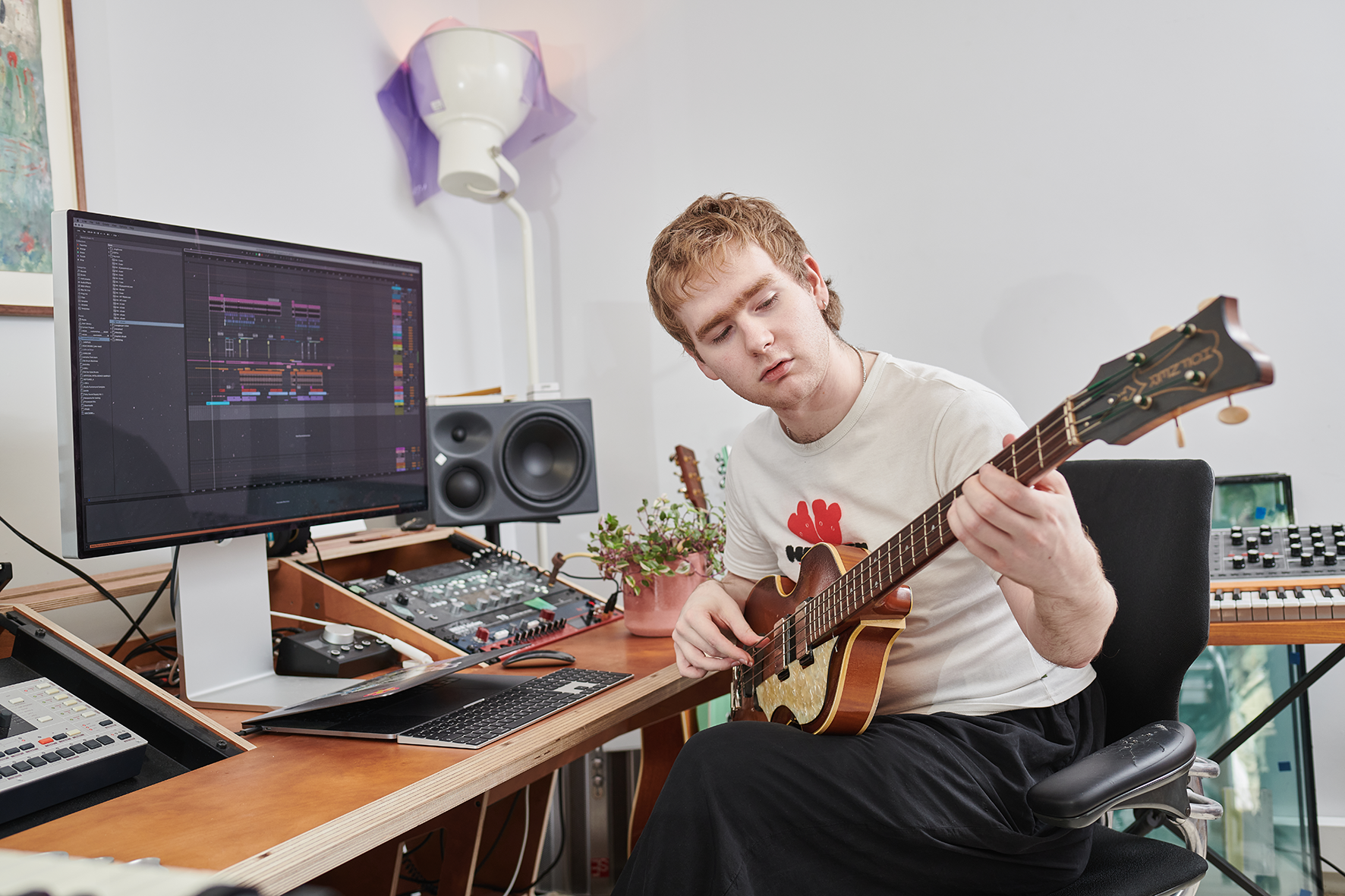
You’ve mentioned previously that with RYC, you skipped the difficult second album and went straight for the ‘weird fourth album’. What does that make demon time?
“Maybe it makes it a renaissance. If we're skipping two and three, and R.Y.C. was four, maybe the fifth is the return to form. Because I understand that the second album, that wasn't really what a lot of people wanted out of me. But I just felt a genuine desire to truly subvert the expectation and do it in a way that I found really interesting. So I suppose this album was like, accepting having been on the zigzag journey. Having done that, and coming back to a place of real familiarity - and experimentation.”
Have you found that difficult, struggling with expectations that might be placed on you and your music?
“Making popular music is a push and pull of doing things that excite an audience and subvert their expectations and are interesting, but also doing things that are palatable, and understandable in a way that is elegantly simple. It's always a back and forth in my head between like, are people going to understand this crazy, esoteric idea on my hard drive, or is there a way to put it in a different context that actually makes it really vital, and culturally relevant?”
Was the whole album recorded in your home studio?
“It was entirely recorded in that little room back there, excusing some remote vocals that came in from international artists.”
Did most of your collaborators manage to get into the studio with you here?
“It was probably like 70% here and 30% elsewhere. I love getting people here into the home environment and taking the pressure off.”
Is that important to you as a producer, shaping the vibe and the space into something that’s conducive to creativity?
“I think that’s a thing that a lot of producers miss when they're sharpening their skills. There's a lot of focus on technicality. But there's a whole thing where you have to shape what happens in a room and make sure you're capturing every moment in some way. I'm a big fan of the phone, I’m constantly recording voice notes. And I always go across the road with them to my favourite coffee spot beforehand, and we’ll just talk, sometimes we don't make any music, because we're just hanging out. But I think that could be considered part of the role of being a producer. It’s curatorial, I think.”
People come up with their best ideas when they feel comfortable.
“Exactly. You get the most honest representation of what they're wanting to do, as well. You can trick people sometimes into being too comfortable, and then they reveal something about themselves. That makes for really great music. I always say, particularly with vocalists, the thing that you say or the lyric that you say in the studio as a joke, to make other people laugh, maybe that you don’t really mean, that’s the one you have to keep in. That is very naked, that’s vulnerable. Vulnerability in music is very important, it’s what connects it to people.”
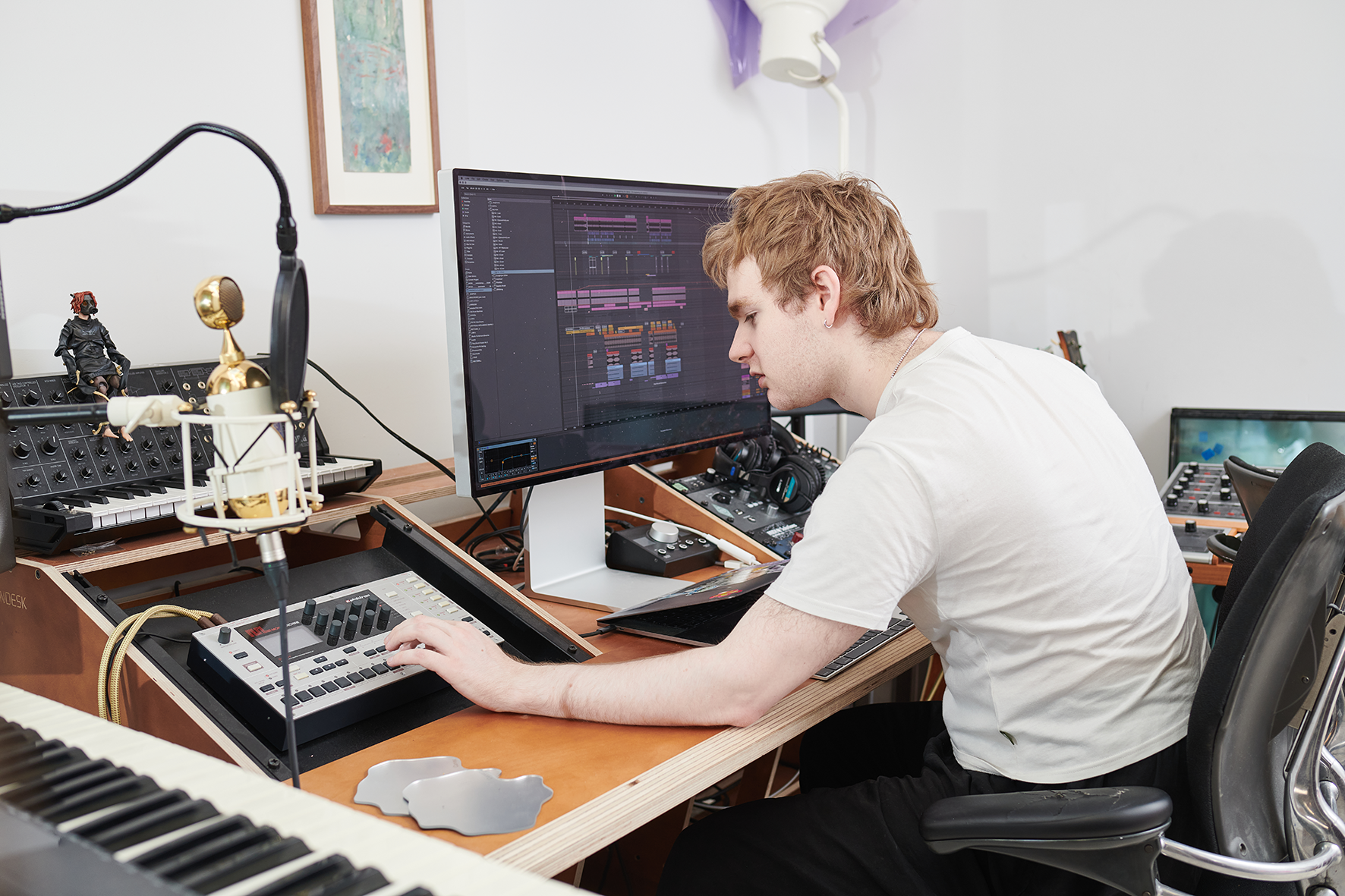
You’ve talked before about vulnerability becoming an increasingly visible theme in modern music.
“When I said that I was speaking about Billie Eilish, a little bit. The new pop paradigm is this very revealed intimacy, and I think it has a lot to do with social media as well. We have a lot of access to people's lives and that can shape the nature of music.”
What do you feel has been the most significant change in your approach to music-making between this album and R.Y.C.?
“I embarked on a different process this time, because the driver behind the decision-making was spontaneity and mischief and fun. So I wanted to create an environment where that could happen with very few time-consuming constraints.
“I created a palette, like a painter would have: drum samples, synth patches, other kinds of sounds and effects and little tags and stuff. I've got a big folder in my sample library just called demon time. And it’s all sounds that I felt reflected that attitude. So that when I did get in the room with people, it was just a case of pulling from that canvas, or pulling from that palette.
I'm always trying to close that gap between having the idea and being able to put it down
“There was no thinking, oh, now I have to worry about whether this drum sound sounds the way I want it to. I could just be like, oh, I need a clap. I've got 10 demon time-sounding claps here. That is a different way around from the way I would do it normally, where I would do everything in the room. But it really sped up that process of having an idea and then immediately having the resources to make it. I'm always trying to close that gap between having the idea and being able to put it down.”
So you’re trying to minimise that in-between period where you lose the creative spark?
“I think a lot of people suffer from that in technical studio settings, where it's like: oh, I've got this really amazing idea but I have to sit down at my synth, shape the sound, patch things in and then record it in a certain way. There's a lot to be said for doing some of that previously outside of a quote-unquote creative environment, where it's just focusing on the technical aspects of the sonics. It's something that I'm definitely going to carry forward because it's worked really well. It means that in a session, you're not wasting time going through 100 kick samples. I’m a big fan of that.”
Where do you find your samples?
“I try not to directly sample from records. More than anything for publishing reasons. Also, I find if you hear something that you like, and you try and recreate it, you're never gonna get exactly close, but what you will get is something that is a little bit different in a way that you can't help.
“For this album, I was creating the drums with synthesisers. I’ve got the Elektron Monomachine - that’s been revelatory. I'm a big fan of Reddit drum kits that people post, the 'trap kits' circuit, I’m very well versed in that. I'm an occasional Splice user, I think that’s fun. But never the charting stuff. You gotta go in with a keyword and really search for the weird thing.
“One thing I love to do is just set a track recording, and just really authentically fuck around on a synth for like 20 minutes, and then spend another 20 minutes listening back to it and marking off sections. That's actually what I was doing before this interview - I was doing a big Monomachine jam.”

So you’re sampling your own jams, in a way.
“Exactly. That's something that Flume put into my head. I saw him doing it. That is a really good way to get to the crux of that messing-about vibe. Sampling it, resampling it and putting it into a granulator.
“One of my production idols is Arca. She occasionally does these live streams where she's showing her process, and it's very destructive. She'll print the reverb onto the track, then chop that up. There's no restraint, no thinking ‘I should plan for the future by bussing this thing out, or separating it.’ It’s very spur of the moment. That's been super inspiring.”
Listening through the album, you’re referencing a really diverse range of styles. What do you think the common thread is running through your music?
“I don’t know - I try not to deep that too much. Because some people really do have a thing, and it used to bug me that I didn't really have a defining... like, oh, he does X, he does that thing really well. But it’s just that over time, given enough work, those subconscious decisions become apparent to the listener. I guess the key difference with this record is the fact that I spent a lot of time creating the sonic identity before I made the music. So there is that cohesiveness. I just took to saying things like, oh that snare is so ‘demon time’. It's kind of an ineffable thing.
Antares Auto-Tune, I gotta be honest, that goes on almost everything
“It sounds how the album cover looks, that’s how I think, like: that would sound good, given the whole aesthetic. Maybe it’s that, maybe it’s the way I curate what the collaborators were doing, also. I try to pick quite carefully which ideas I use from them and I'm often stitching together hooks out of what they do, or getting them to improvise for 20 minutes, and then creating the song out of that. Maybe it's some sort of invisible thing like that. I think I just try to trust myself and hope that it comes out sounding a little bit like Mura Masa.”
When it comes to working with collaborators, do you have a particular process, or are you taking a new approach with each person?
“I'd say the commonalities are talking to them about what they're really interested in at that moment. That's always a good starting point, because the answer always surprises you. You’ll get in with a reggaeton artist, thinking you're gonna make some reggaeton, and then be like, what are you really interested in? And they'll be like, oh, I'm listening to loads of Portishead. Then you just follow that. Then they’re happy because they’re not being pigeon-holed, and you’re trusting them to do something a little bit different.
“I always describe it as putting one foot into their world, they're putting one foot into my world, and we're making something that neither of us would have come across. But yeah, it's case by case. Some people have a very clear idea of what they want from me and I respect that. Or if I'm working on somebody else's project, then it's about me making suggestions about what I'd like to hear from them, and I’m feeding back off that.”
Can you talk us through one or two bits of equipment that were fundamental to the making of demon time?
“The Ableton 11 Drum Buss is crazy. It does nuts things to drums, it just makes them sound better. That's how I'd describe it. It has a great transient shaper, there's some distortion built in there. I use that all the time.
“Antares Auto-Tune, I gotta be honest, that goes on almost everything. Even if it's not doing the legwork of actually tuning the vocal, sometimes I'll tune the retune speed to really long so it's not actually tuning the vocal. There’s something about the way the vocal gets processed, it has this weird digital sheen on it. That’s become part of the lexicon of pop music vocals - it’s a really powerful thing.”
The Monomachine is amazing. It’s the best-kept secret. I don’t know what’s wrong with people - everyone should have one!
“The Abbey Road TG Mastering Chain, from Waves. Again, this is going to make somebody who’s reading this very mad, but I’m not entirely sure what it does. Somebody recommended it to me and I bought it. There’s a certain thing I do every time - I’ll turn the top left knob to 7.5 and one of the middle knobs a quarter of the way. Whatever that combination is, I settled on it, and it makes everything sound better.”
“The DFAM got used on a couple of songs, as I mentioned. And the Monomachine is amazing. It’s the best-kept secret. I don’t know what’s wrong with people - everyone should have one! I guess they do cost two-and-a-half grand, and they’re quite hard to find. SOPHIE was one of my biggest influences of all time, and Autechre as well, and they’re both big proponents of the Monomachine.”
“Frank Dukes, the producer, has made this soft synth for a company called Cradle, called The Prince. It’s really interesting. There's a noise module in there that has ocean sounds on it. It's the exact kind of thing I like - you can just scroll through the presets and fiddle with some stuff, and you'll get something.
“The MS-20 is worth a mention. There’s something about a monosynth that only has a couple of options for waves and a noise generator. And obviously the famous filter. That got used a lot for little solo-y bits and arpeggio flourishes. A lot of Soundtoys, as well. Shout out Soundtoys - I love Echoboy.”
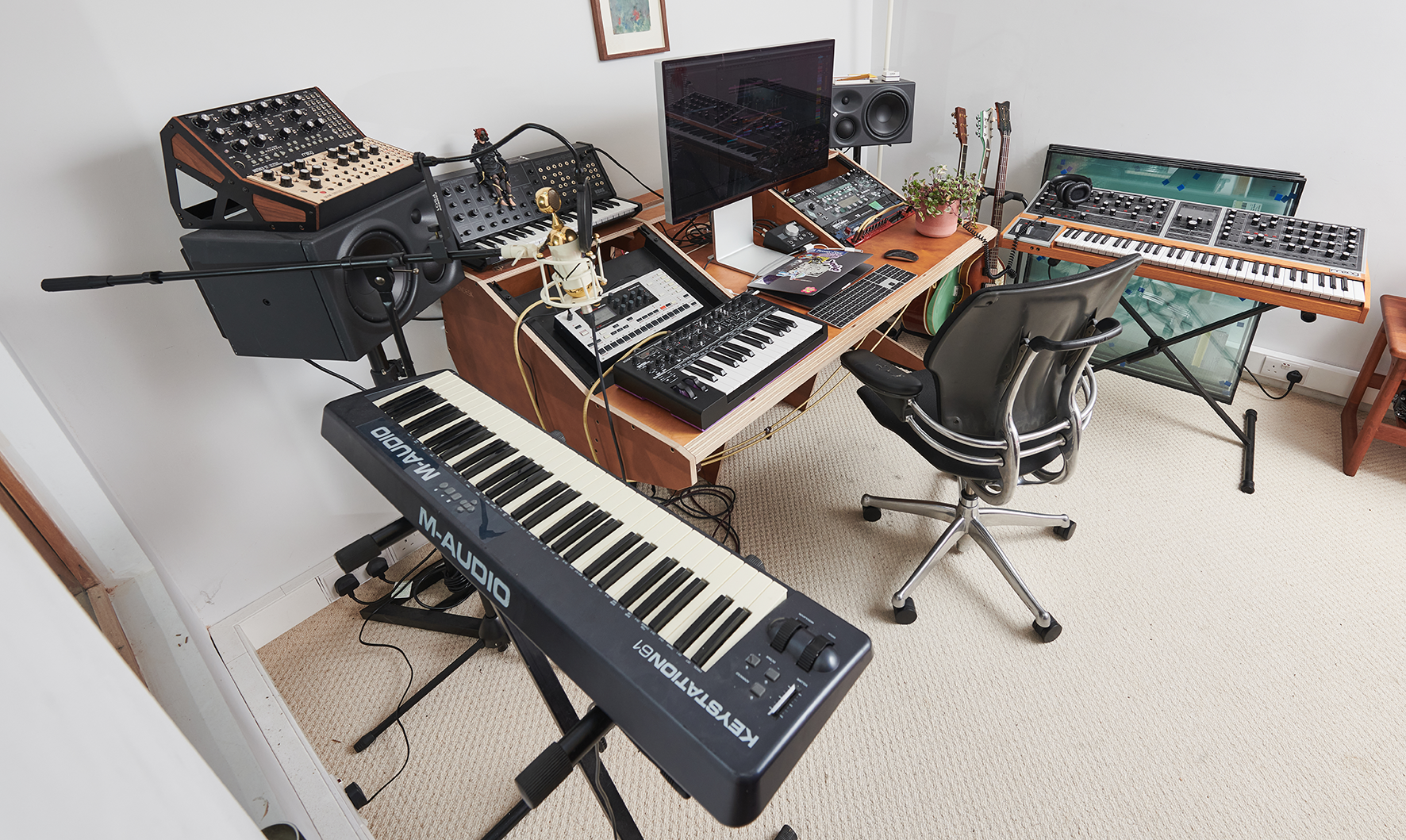
Is that something you’re drawn to more generally, synths or instruments that limit your options?
“Yeah, exactly. I only really get the Moog One out when I want the one specific thing, really warm pads and things like that. I think I'm attracted to things that have really heavy limitations, because it's almost like a challenge, isn't it? Like, I bet I could get a banging sound out of that. I get the same feeling when I see a beat-up guitar with two strings on it: I bet I could get that to sound really interesting.”
Have you ever been tempted by the modular world?
“I've got a few semi-modular bits, the MS-20 has some modular aspects. But I think that's something I'll probably wait until I’m 35 for. I’ll dive in on that when I have lots of time and money. Having said that, though, what I do is search for people who've made sample packs from their modulars. Because there is something interesting about their crazy nature. But yeah, I can't say I've got my rack yet.”
Are you still learning new techniques in production, or is that something that happens more in the process of messing around and experimenting?
“It’s the latter. I read this interview with Daft Punk once, when they were making Discovery. They explained that they read the manuals for the synths that they own back to back, once a week to keep things familiar. And I was like, that's so cool, I'm gonna do that, that's amazing.
I like bragging about using stock plugins, because you don’t need some crazy $500 multiband compressor
“But then I found myself attracted to the idea of just turning something on and essentially just messing around with it. In a way, that's a curatorial approach, isn't it? It's not necessarily about knowing exactly how to make the sound, it's about when you stumble across something, being able to hear it and know there's a rabbit hole there to go down there.
“But in terms of new processes, the whole destructive workflow thing has been really interesting. Not getting too hung up on separation of tracks and bussing effects and things like that. That's been a big weight lifted, to be honest, and it's another thing that shortens the process, because you're not fumbling over routing and things like that.”
Do you use any outboard gear for effects processing?
“Something I actually want to explore next is working with some outboard stuff and reamping some synths. Mostly I just use - and this goes for everything - I just use what's to hand. I use a lot of Ableton stock stuff just because it's the quickest thing to drag in. Again, I’m trying to close that gap between having the idea and getting it out.”
“I like bragging about using stock plugins, because you don’t need some crazy $500 multiband compressor. Maybe that’s what I want people to take away from this is how incompetent I really am. [laughs] There's a whole approach that does away with the technical snobbery of production, that is just about output. Like - does it sound good coming out of the master bus? It’s a very minimalist approach.”
I don’t work with reverb when I’m writing, I wait right to the end. It makes sure that what you’re doing is good on its own
“I think a lot of people my age, and kids who are coming out now really admire the Rick Rubin school of thought, like: what can we take out? How can we get this down to its bare essentials? And dryness, too. Not covering everything in reverb if it doesn’t call for it, really getting closeness and intimacy. It’s revealing. I don’t work with reverb when I’m writing. I wait right at the end to do all that stuff. It makes sure that what you’re doing is good on its own.”
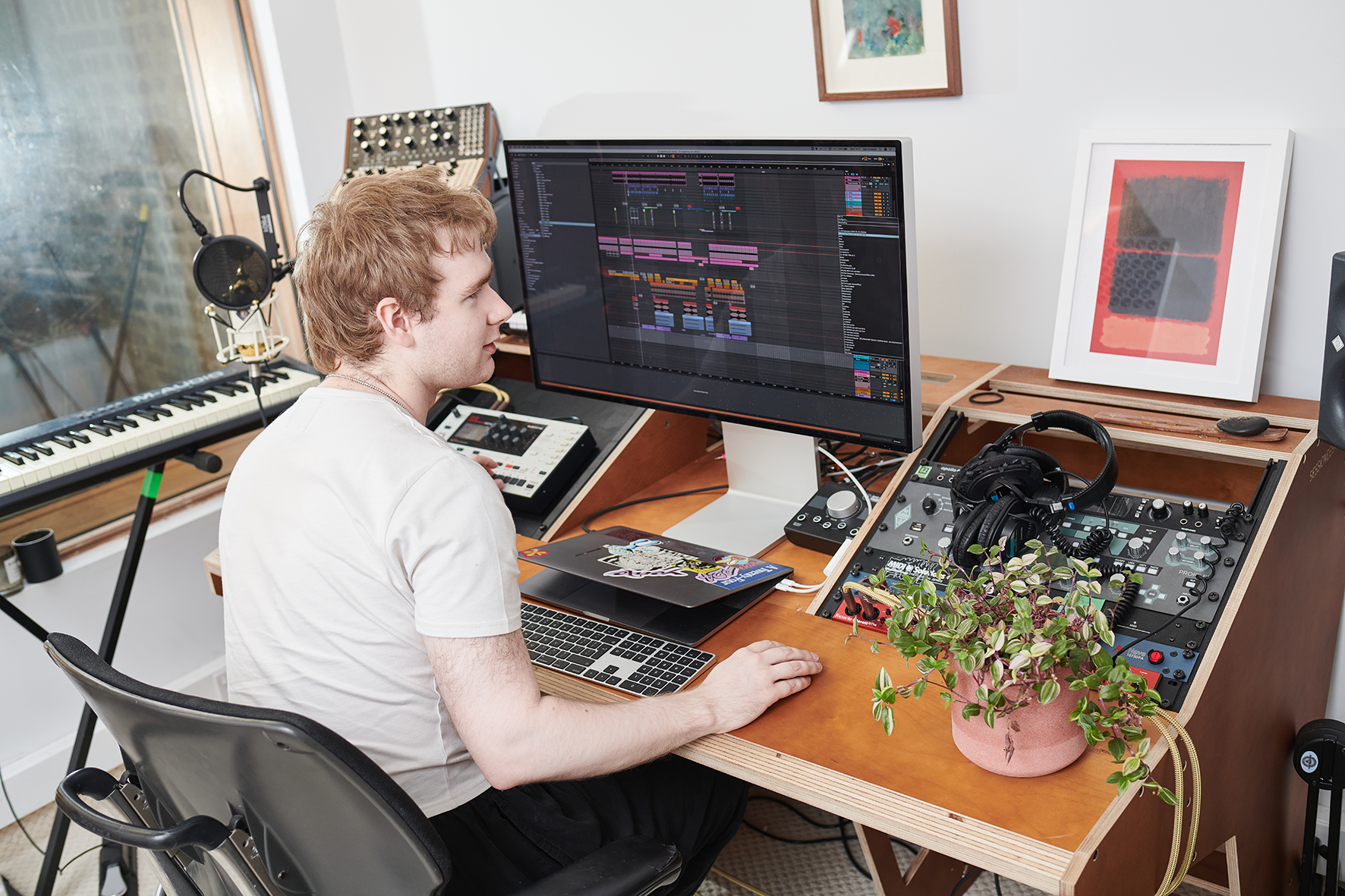
You mentioned you used the bass guitar on some of the tracks on this album?
“Normally what I do if I'm using the bass guitar is, I'll try my best to get a lot of the bass frequencies that I want out of the bass guitar with EQ and compression and stuff. But then if that's not working, I'll put a massive shelf, 100Hz, on the bass guitar and then go in and retrack a sub bass under it, doing the exact same thing. So it's layered, you get the quality of the real bass and the sound of the strings and plucking but you get that way, down-low 30Hz sub quality. A track like “prada” has that sort of thing going on.”
Do you mix as you’re working or leave that process to the end?
“I'm mixing as I'm producing. For me, I really didn't understand, when I learnt to produce, that they were different things. Isn't the mix just as creative a process as the production? So I didn't really understand the separation between the two things. Now I understand it a little bit more. But as I was learning, that was part of it for me, cause I've learned how to make it sound good, how to use the mixing process to get a creative output.
It's probably a profound laziness, but I don't tend to get loads of new gear in all at once
“Nathan Boddy, who mixed this album, is really receptive to that. He just takes it over the line, with his amazing knowledge and taste. But I’ll come to him with something that I would consider pretty mixed. He says he loves me for that. When I send it to him, I’ll think yeah, I’m pretty happy with this mix. But he makes it ten times better. It’s a really good working relationship. It’s good to have a longer-term relationship like that, somebody who knows how you want to sound and how to fill the gaps in your knowledge.”
So you’re working in Ableton. Is that something you’ve always used?
“I started out on Sony ACID. I saw a video of Rusko, the dubstep producer, using it. I was like - that must be the way! [laughs] I heard that Burial uses Sound Forge, so I tried that out. I went through a Cubase week. I tried FL Studio, because all the rap producers use it.
“But Ableton has the right mix. There's quite a steep learning curve when you get into it, but once you get a handle on the workflow, it's so convenient. There's so many shortcuts, there's so many quality-of-life things are really great about it.
“When I started using it, I considered it to be more of a sequencing-type program, not something for recording audio. But I think they've made real strides into making it really suitable for recording. Even just with the Comping in Live 11. I think there’s a pivot on Ableton towards the realisation that some of the world’s top producers have been using it to produce quite audio-intensive music. I love it.”
How often are you experimenting with new gear?
“It's probably a profound laziness, but I don't tend to get loads of new gear in all at once. I'll get one thing and leave it on a shelf for four weeks, remember I've got it, play with it for a couple of days, harvest a lot of samples from it, then it goes back on the shelf. I don't have a huge collection of stuff. But I've got a rotation of main synths. The Moog One is out at the moment, I've got a Prophet-5, I've got a Poly Six which is amazing. That’s kind of it, between those, the DFAM, the MS-20, the Monomachine, which is my favourite bit of gear, ever.”
Aside from the Frank Dukes plugin, what soft synths are you using?
“Massive, I use if I need a utilitarian, one-oscillator thing. Also what I use a lot is Analog Lab. It’s got whatever you need. If I need a Wurlitzer - there it is, there's 50 options there from different decades. It’s incredible. That was a game-changer for me. I’m very lazy and I hate having to go, oh where’s the Wurlitzer, it’s in Kontakt somewhere… in Analog Lab, it’s all in one thing, with a search bar.”
Is there anything on your wishlist studio-wise?
“The pedals thing is interesting to me. I've got the Kemper Profiler. But there is something tactile about having pedals laid out, and being able to rewire everything. Not necessarily for guitar either. One thing I'm really interested in is hooking up the Monomachine to a few pedals and making some drones.”
The joy of being a producer, especially when you're young, is like: okay, I can't afford to hire an orchestra. What's the workaround?
“I really want a banjo, but maybe that's a bit of a left answer. I feel like the banjo isn't being utilised in any leftfield ways. It’s got this potent nostalgia to it. I’d like to collect a few more classical instruments as well. I’d love to get a cello or a double bass and slowly teach myself to play.”
Have you recorded with a string section before?
“A while ago I recorded with a string quartet. It really depends what you're doing, I'd be more likely to do that for someone else's record. But I think the point of being a producer, and the joy of it, especially when you're young, is like: okay, I can't afford to hire an orchestra. What's the workaround? And you get this weird result that isn't quite right and doesn't sound how you want it, but it's got that unique energy to it. It’s a bit like Paul McCartney discovering a Mellotron and being like, ‘what, I’ve got a whole orchestra?’ It’s a lateral solution to a problem, instead of having to fly to Serbia and do the whole thing.”

What’s your live set-up like?
“It’s just me and my vocalist, Fliss. It’s really cruel to expect somebody to be able to go from being A$AP Rocky into being Charli XCX into Pinkpantheress, but she’s probably the only person on earth who can do it consistently, and put on a performance. It’s another way that I like to be curatorial. She’s performing the show, I’m just creating the environment for her to get people excited.
The mantra for the live show is, what’s the most interesting thing happening musically at any one point in a song? Whatever that is, I’m performing it
“It’s a deceptively simple set-up. I’ve got a MIDI keyboard, a couple of SPDs triggering drum samples. There’s a few real drums, toms on one side, a snare on the other. Crash cymbals, they’re important. I’ve got a guitar. Then there’s some lowkey Akai controllers and little button things. I think for my music, the esoteric, button-pressing, is-he-really-doing-anything vibe doesn’t really suit it. The mantra for the live show is, what’s the most interesting thing happening musically at any one point in a song? Whatever that is, I’m performing it.”
Finally, we heard that you’re building a new studio at the moment?
“There’ll be a big emphasis on social space. People think of studios as places of productivity. But a big aspect of studio work for me is chance meetings, and finding out who's working next door. It's an opportunity to network with peers and contemporaries. So I want that to be the emphasis of the studio. We’re setting it up as a community-led space. I want to make it a social space where people can hang out as well as making music.
“I wanted to create something that could exist outside of the context of me even being an artist. It might be that one day I move to LA and I'm not even in this space, it'll just be bubbling along on its own. I'm really into this idea of the Warhol-style factory that everyone rolls through. There's an opportunity for not just musicians, but other types of creatives to occupy the space. It’s a big undertaking. It’s the most exciting, complex thing I’ve ever done.”



I'm MusicRadar's Tech Editor, working across everything from product news and gear-focused features to artist interviews and tech tutorials. I love electronic music and I'm perpetually fascinated by the tools we use to make it.